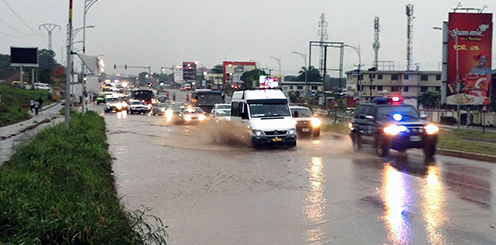CLIMACCESS project initiation

In a fast-growing city as Accra, challenged by unsustainable spatial development practices and increased frequency of extreme weather events, mobility forms an integral part of livelihood strategies and of strategies for reducing the vulnerability of local communities.
Flooding severely affects and hampers mobility by effectively disabling parts of the transport network thereby contributing to the pervasive and exacerbating accessibility problems that characterized the city.
Therefore, while previous studies highlight how mobility-constraints reduce access to work, limit the number of accessible jobs, constrain access to services, prevent the development of social networks and contribute to processes of social exclusion1 this project emphasis the links between climate change resilience, urban accessibility and the mobility of urban residents.
Objectives
The objectives of CLIMACCESS project is to establish a comprehensive understanding of the physical and human factors that determine resilience to climate change impacts on mobility and accessibility in the Accra region. This is accomplished by enhancing research capacity in the field, introducing new methods for mobility analysis, new methods for predicting urban floods, and by devising policy and planning measures to advance the sustainable urban development agenda.
The project will pursue this objective through novel research and methods-development in an interdisciplinary setup with four sub-objectives:
Work package A. Urban mobility patterns, livelihood strategies and vulnerability
The objective of this package is to explore local mobility patterns and practices imbedded in the livelihood strategies of urban residents in four selected urban settlements, and to analyze these practices within the context of climate change resilience. The research will explore how mobility practices and livelihood strategies are shaped and constrained by reduced or variable accessibility levels and vulnerability related to extreme weather events. The research will furthermore explore household- and community-level responses, as well as more long-term strategies to reduce vulnerability and build resilience. This will provide a framework for understanding the consequences of reduced or fluctuating mobility levels due to more frequent extreme weather events, and feed into the overall discussion of livelihood vulnerability and climate change resilience among local communities.
Work package B. Scenarios of climate change and urban flooding
The objective of this package is to analyze how climate change will affect future urban flooding patterns. The research will focus on the influence of climate change on the future precipitation pattern in the region and the expected future urban flooding levels as a consequence of extreme weather events. It will apply a newly developed method for forecasting how storm-water will flow in urban areas during extreme rain events (Balstrøm & Crawford, forthcoming) as well as mapping using a small UAV (“drone”) equipped with a Lidar scanner. These methods are expected to provide the means to identify and map the areas in risk of flooding on the full urban scale. This information will provide valuable estimates of where increased runoff volumes due to climate changes may have severe impacts on existing or planned transport infrastructure.
Work package C. Transport network analysis: Impact of flooding on urban accessibility and mobility
The objective of this package is to analyze the vulnerability of the transport system within the context of current urban spatial development practices using novel applications of spatial network analysis tools. The aim is to analyze spatially how flooding events directly affect the transport network by reducing network connectivity, accessibility and general speed levels, and how this further affects levels of mobility and accessibility in different urban areas. By linking accessibility analysis with flood maps resulting from work package B. the research is expected to result in a new ‘vulnerability map’ of the transport network in different parts of the city area and spatial projections of accessibility and mobility levels under future climate change-scenarios.
Work package D. Towards a comprehensive understanding of the interplay between climate change, urban accessibility and the mobility of urban residents.
This work package will run in parallel with the other work packages and has multiple objectives: 1) to coordinate the research in work package A-C and facilitate the start-up phase, including stakeholder identification and case site selection, 2) to facilitate the production of joint scientific papers and policy briefs based on the research results obtained in work package A-C, and 3) to specifically address capacity building within the field both in the participating research institutes and among stakeholders, based on training, supervision and workshops as described further below. The aim is to develop and disseminate a comprehensive holistic and multi-scale perspective on climate change resilience in relation to urban mobility and accessibility and the research will provide strategies for decreasing vulnerability to extreme weather events.
1 WB 2002, Olvera et al. 2003, Salon & Gulyani 2010, Bocarejo & Oviedo 2012


